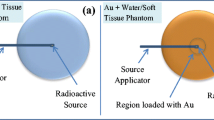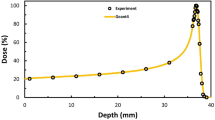Abstract
The aim of this study was to quantify the dose enhancement by gadolinium and gold nanoparticles in brachytherapy. MCNPX Monte Carlo code was used to simulate four brachytherapy sources: 60Co, 198Au, 192Ir, 169Yb. To verify the accuracy of our simulations, the obtained values of dose rate constants and radial dose functions were compared with corresponding published values for these sources. To study dose enhancements, a spherical soft tissue phantom with 15 cm in radius was simulated. Gadolinium and gold nanoparticles at 10, 20 and 30 mg/ml concentrations were separately assumed in a 1 × 1 × 1 cm3 volume simulating tumour. The simulated dose to the tumour with the impurity was compared to the dose without impurity, as a function of radial distance and concentration of the impurity, to determine the enhancement of dose due to the presence of the impurity. Dose enhancements in the tumour obtained in the presence of gadolinium and gold nanoparticles with concentration of 30 mg/ml, were found to be in the range of −0.5–106.1 and 0.4–153.1 % respectively. In addition, at higher radial distances from the source center, higher dose enhancements were observed. GdNPs can be used as a high atomic number material to enhance dose in tumour volume with dose enhancements up to 106.1 % when used in brachytherapy. Regardless considering the clinical limitations of the here-in presented model, for a similar source and concentration of nanoparticles, gold nanoparticles show higher dose enhancement than gadolinium nanoparticles and can have more clinical usefulness as dose enhancer material.




Similar content being viewed by others
References
Ranjbar H, Shamsaei M, Ghasemi MR (2010) Investigation of the dose enhancement factor of high intensity low mono-energetic X-ray radiation with labelled tissues by gold nanoparticles. Nukleonika 55(3):307–312
Rahman WN, Bishara N, Ackerly T, He CF, Jackson P, Wong C et al (2009) Enhancement of radiation effects by gold nanoparticles for superficial radiation therapy. Nanomedicine 5(2):136–142
Lamprecht A, Yamamoto H, Takeuchi H, Kawashima Y (2005) Nanoparticles enhance therapeutic efficiency by selectively increased local drug dose in experimental colitis in rats. J Pharmacol Exp Ther 315(1):196–202
Iwamoto KS, Cochran ST, Winter J, Holburt E, Higashida RT, Norman A (1987) Radiation dose enhancement therapy with iodine in rabbit VX-2 brain tumors. Radiother Oncol 8(2):161–170
Robar JL (2006) Generation and modelling of megavoltage photon beams for contrast-enhanced radiation therapy. Phys Med Biol 51(21):5487–5504
Leung MK, Chow JC, Chithrani BD, Lee MJ, Oms B, Jaffray DA (2011) Irradiation of gold nanoparticles by X-rays: Monte Carlo simulation of dose enhancements and the spatial properties of the secondary electrons production. Med Phys 38(2):624–631
Zhang SX, Gao J, Buchholz TA, Wang Z, Salehpour MR, Drezek RA et al (2009) Quantifying tumor-selective radiation dose enhancements using gold nanoparticles: a Monte Carlo simulation study. Biomed Microdevices 11(4):925–933
Cho S, Jeong JH, Kim ChH, Yoon M (2010) Monte Carlo simulation study on dose enhancement by gold nanoparticles in brachytherapy. J Korean Phys Soc 56(6):1754–1758
Aziz EF, Bugaj JE, Caglar G, Dinkelborg LM, Lawaczeck R (2006) Novel approach in radionuclide tumor therapy: dose enhancement by high Z-element contrast agents. Cancer Biother Radiopharm 21(3):181–193
Lechtman E, Chattopadhyay N, Cai Z, Mashouf S, Reilly R, Pignol JP (2011) Implications on clinical scenario of gold nanoparticle radiosensitization in regards to photon energy, nanoparticle size, concentration and location. Phys Med Biol 56(15):4631–4647
Berbeco RI, Ngwa W, Makrigiorgos GM (2011) Localized dose enhancement to tumor blood vessel endothelial cells via megavoltage X-rays and targeted gold nanoparticles; new potential for external beam radiotherapy. Int J Radiat Oncol Biol Phys 81(1):270–276
McMahon SJ, Hyland WB, Muir MF, Coulter JA, Jain S, Butterworth KT et al (2011) Biological consequences of nanoscale energy deposition near irradiated heavy atom nanoparticles. Sci Rep 1:18
Garnica-Garza HM (2010) A Monte Carlo comparison of three different media for contrast enhanced radiotherapy of the prostate. Technol Cancer Res Treat 9(3):271–278
Regulla DF, Hieber LB, Seidenbusch M (1998) Physical and biological interface dose effects in tissue due to X-ray-induced release of secondary radiation from metallic gold surfaces. Radiat Res 150(1):92–100
van den Heuvel F, Locquet JP, Nuyts S (2010) Beam energy considerations for gold nano-particle enhanced radiation treatment. Phys Med Biol 55(16):4509–4520
Sahoo S, Selvam TP, Vishwakarma RS, Chourasiya G (2010) Monte Carlo modeling of 60Co HDR brachytherapy source in water and in different solid water phantom materials. J Med Phys 35(1):15–22
Browne E, Dairiki JM, Doebler RE (1978) Table of Isotopes, 7th edn, Lederer CM, Dhirley VS (eds), Wiley Inc., New York
Medich DC, Munro JJ III (2007) Monte Carlo characterization of the M-19 high dose rate Iridium-192 brachytherapy source. Med Phys 34(6):1999–2006
Cazeca MJ, Medich DC, Munro JJ III (2010) Monte Carlo characterization of a new Yb-169 high dose rate source for brachytherapy application. Med Phys 37(3):1129–1136
Papagiannis P, Angelopoulos A, Pantelis E, Sakelliou L, Karaiskos P, Shimizu Y (2003) Monte Carlo dosimetry of 60Co HDR brachytherapy sources. Med Phys 30(4):712–721
Dauffy LS, Braby LA, Berner BM (2005) Dosimetry of the 198Au source used in interstitial brachytherapy. Med Phys 32(6):1579–1588
Williamson JF, Li Z (1995) Monte Carlo aided dosimetry of the microselectron pulsed and high dose-rate 192Ir sources. Med Phys 22(6):809–819
Medich DC, Tries MA, Munro JJ III (2006) Monte Carlo characterization of an ytterbium-169 high dose rate brachytherapy source with analysis of statistical uncertainty. Med Phys 33(1):163–172
Waters LS (2000) MCNPX User’s Manual, Version 2.4.0. Report LA-CP-02-408, Los Alamos National Laboratory
Bahreyni Toossi MT, Ghorbani M, Mowlavi AA, Taheri M, Layegh M, Makhdoumi Y et al (2010) Air kerma strength characterization of a GZP6 Cobalt-60 brachytherapy source. Rep Pract Oncol Radiother 15:190–194
Rivard MJ, Coursey BM, DeWerd LA, Hanson WF, Huq MS, Ibbott GS et al (2004) Update of AAPM Task Group No. 43 Report: a revised AAPM protocol for brachytherapy dose calculations. Med Phys 31:633–674
Cristy M, Eckerman K (1987) Specific absorbed fractions of energy at various ages from internal photon sources, ORNL Report No. ORNL/TM-8381/VI, Oak Ridge
Acknowledgments
The authors would like to thank Mashhad University of Medical Sciences (MUMS) for funding this work.
Author information
Authors and Affiliations
Corresponding author
Rights and permissions
About this article
Cite this article
Bahreyni Toossi, M.T., Ghorbani, M., Mehrpouyan, M. et al. A Monte Carlo study on tissue dose enhancement in brachytherapy: a comparison between gadolinium and gold nanoparticles. Australas Phys Eng Sci Med 35, 177–185 (2012). https://doi.org/10.1007/s13246-012-0143-3
Received:
Accepted:
Published:
Issue Date:
DOI: https://doi.org/10.1007/s13246-012-0143-3




